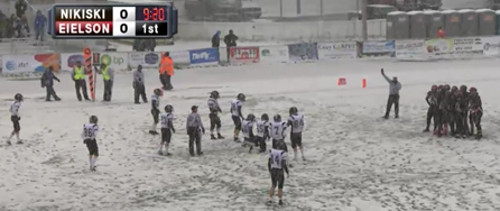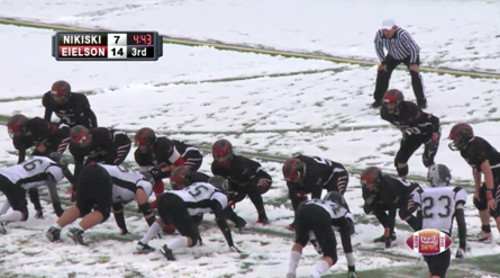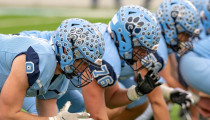A key component to the NFHS rules books is safety. Over the years, rules have been modified and developed to level the playing field with a focus on player safety. Player safety is addressed throughout both the NFHS Football Rules and Case Book emphasizing player actions, equipment and game management.
In Alaska, we find many of the same situations that are encountered throughout the “Lower 48”. In Alaska, young men play with the same intensity as their counterparts, wearing the same state of the art protective gear and on occasion, endure weather delays for lightning. A topic that is not addressed in the Rules or Case Book is cold weather preparation for officials.
While Alaska is not the only state that experiences cold weather, it is more prevalent and inevitable as the season extends into late October. Factors such as below-freezing temperatures, wind and snow all can affect game safety, coaching strategies and game management. As an official, these aspects must all be considered and planned for before the opening kick-off.
Prior to any game, it is prudent to include a weather forecast as part of the pregame studies. Officials make a point of preparing to officiate specific teams, noting their tendencies and player abilities; but should also review and prepare for weather conditions.

The first progression of preparation focuses on the uniform. Generally, an official has a uniform repertoire that can range from mesh short-sleeved stripes to Gortex, waterproof shells to stay warm and dry. Often, uniform attire is decided during pregame crew discussions. It is vital to be prepared with appropriate uniform attire to adapt to the weather conditions with the awareness that the possibility exists of a halftime uniform change.
Cold weather preparedness for an official should include duplicates of uniform items and equipment. A moisture wicking, base-layer under the outer stripes and black pants is a must, and having the opportunity at halftime to remove, add or switch out layers will enhance the official’s ability to concentrate and remain focused on the game. Switching into a fresh, clean dry pair of shoes and socks at halftime can seem almost heavenly. Cold, wet feet can create a miserable feeling in any situation. A cold gear hood can be used to keep the face and ears warm; however, the drawback to wearing a hood can be difficulty hearing verbal communication. Thin gloves for handling a ball is still requisite and may further interfere with a finger whistle if used.
Officiating equipment remains consistent, but duplicates of items such as pencils, whistles and flags can keep one out of a bind in the event that a pencil happens to bounce out of a pocket and disappear into the snow or a whistle freezes up only to produce a gasp of air rather than the loud blast to stop play.
Part of the pregame should also include a non-static stretching period. Proper muscle warm-up should be dynamic for full range of motion to promote blood flow. In cold temperatures, it is imperative that officials and athletes are adequately stretched to minimize injuries and stay warm. Cold temperatures can rob the body of its fluids, so it is essential that the officials and athletes be properly hydrated.
The field itself should be carefully monitored as icy conditions can be treacherous and snow can make spotting the ball difficult. Game management crews can assist by attempting to shovel the sidelines and goal lines during dead ball opportunities as field positioning allows. Wing officials should make every attempt to keep the sidelines clear of coaches, team members and media as players heading out of bounds often slide and have difficulty stopping to avoid collisions with non-players. Crewmembers should remain wide and allow the play to develop and complete before moving in to mark a spot, as players’ momentum will often extend the play beyond the whistle.

Chain crews should also be aware of the additional dangers associated with the sidelines. Referees should make this a point of discussion in the pregame. The adage “Find the ball before sounding your whistle” is even more important in a game with severe weather conditions. Cold hands, a slippery surface and frozen footballs will all contribute to fumbles, miscues and muffs so it is important to see the entire play to determine if and when a player is down and how that may relate to a loose ball. A non-white beanbag that will contrast with the snow to mark a location will also come in handy.
Having a slow whistle can be useful by allowing an official to determine the correct status of the ball, but also dangerous affecting player safety. It may be unrealistic to expect players to pull up and stop their impetus at the sound of a whistle, so officials must use judgment and restraint with their markers as player intent and basic physics become prevalent. Marking the runner down can be easier during a snow game where there may be tracks or slide marks visible. Wing officials need to be aware of where the runner actually is determined to be down since players will frequently continue to slide beyond the end of the run. Forward progress should not include the slide. When relaying the ball back to midfield, relay throws should be kept short. If you’ve gone to the trouble to replace the ball with a dry one, it makes sense to try to keep it that way. Catching and throwing with gloves can present a challenge. If necessary, walk the ball in to the umpire.
Philosophically, during a game in which weather plays a large factor, an official must exhibit discretion when defining a foul and answer the following questions on virtually every play. Was the infraction a safety concern? Did the foul have an immediate impact on the play? Did one team gain an unfair advantage?
If you can answer yes to any of these questions, you may have a foul. While I’m not suggesting leniency when observing a foul, it is important to reflect on the impact the foul may have had on the play considering the many variables and their influences. In short, make it big.
Officiating in cold weather climates presents many additional challenges unfamiliar to most football games. The familiar thread found in all games played at all levels, in all locations and in any weather is preparation. Being prepared mentally and physically allows the official to focus on player safety, fairness and retaining the essence of the game. Ultimately we officiate to give back to the game and because we enjoy it. A little preparation can make a difference between working a game and having fun officiating.
Brian Hosken
Brian Hosken is the president of the Anchorage Football Officials Association and is a high school activities principal in Anchorage. Hosken has officiated football and flag football for nine years.
Most Recent Articles
- nfhs news NFHS Learning Center Delivers 25 Millionth Course
- Track & Field/Cross Country article Effective Communication with Athletes and Coaches
- nfhs news Player Equipment Changes Highlight 2025 High School Football Rules Revisions
- Player Equipment Changes Highlight 2025 High School Football Rules Revisions
- nfhs news Judgment Call on Second Contact Eliminated in High School Volleyball






